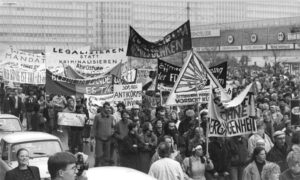Stealing the Future and its sequels have a very simple premise: that East Germany did not get taken over by the West in 1990, but carried on as an independent state. I believe it’s fair to say that many, probably most people in the East Germany (the GDR) in 1989-90 actually wanted to stay independent, and it’s very clear that those who were already in active opposition to the regime before 1989 weren’t aiming for unification with West Germany.
So why did unification happen? That’s a big question, and deserves its own post, but let’s just assume, for the moment, that the citizens of the GDR had withstood the amorous advances of West Germany, had actually, as conjectured in Stealing the Future started dismantling the Marxist-Leninist system of control, replacing it with direct democracy. Would it have been possible to have an economically and politically viable GDR in a post-Cold War Europe?

Since reunification in 1990 the German government has invested heavily in interpreting the causes and course of the changes that began in Autumn 1989. The way the German Government tells this story (through websites, exhibitions, politician’s speeches, media work etc) has changed over the last 25 years. In the first few years after reunification the exhibitions to be found in market squares and town halls across the eastern part of the new Germany (ie the ex-GDR) talked of the power of the people, their rejection of the Communist Party (SED) and their unreserved support for the reunification of Germany. As a young academic at the time I travelled extensively around east Germany, talking to people about their experiences, how they felt about the dramatic changes they had witnessed. Although many were hopeful about the future, some welcoming the potential economic opportunities they felt reunification could bring, not one person I spoke to had, before 1990, felt a burning desire to see a reunited Germany.
“This isn’t how it happened”
There’s a mismatch here – no-one seemed to have wanted reunification, yet hundreds, probably thousands went on demonstrations with placards (most of them specially shipped in from West Germany) twisting the slogan of the revolution (we are the people!) into We are one people – Wir sind ein Volk! Nevertheless, these east Germans stood there, reading the exhibitions thoughtfully paid for by the West Germans and provided by the new regional governments, and they shook their heads. “This isn’t how it happened,” they said to each other.
Fast forward 25 years, and once again the government is gearing up to another massive information campaign (in the old days it was called agitprop or agitation and propaganda), informing its people of the events they brought about all those years ago. The first wave came with the celebrations on the 25th anniversary of the fall of the Berlin Wall on the 9th of November 2014, and more will be following when Unification Day comes around for the 25th time in October 2015.
“The GDR was bankrupt”
The message has changed over the years. If I remember rightly it started with: the people had a peaceful revolution and called for reunification, but just a few years later it had become: the GDR was bankrupt and all those demonstrations in 1989 merely hastened the end by a few months. (Of course neither the messages nor the transition the propaganda went through was as synchronised as that – but the general trend could be observed.)
There’s no denying that the GDR was economically stagnant – factory plant often dated back to pre-war days, gross inefficiencies in resource distribution, political interference from technically-illiterate apparatchiks and a shortage of foreign currency reserves meant that the East German economy was indeed heading for collapse.
In Part 2 we’ll be looking at the economic situation of Stealing the Future.